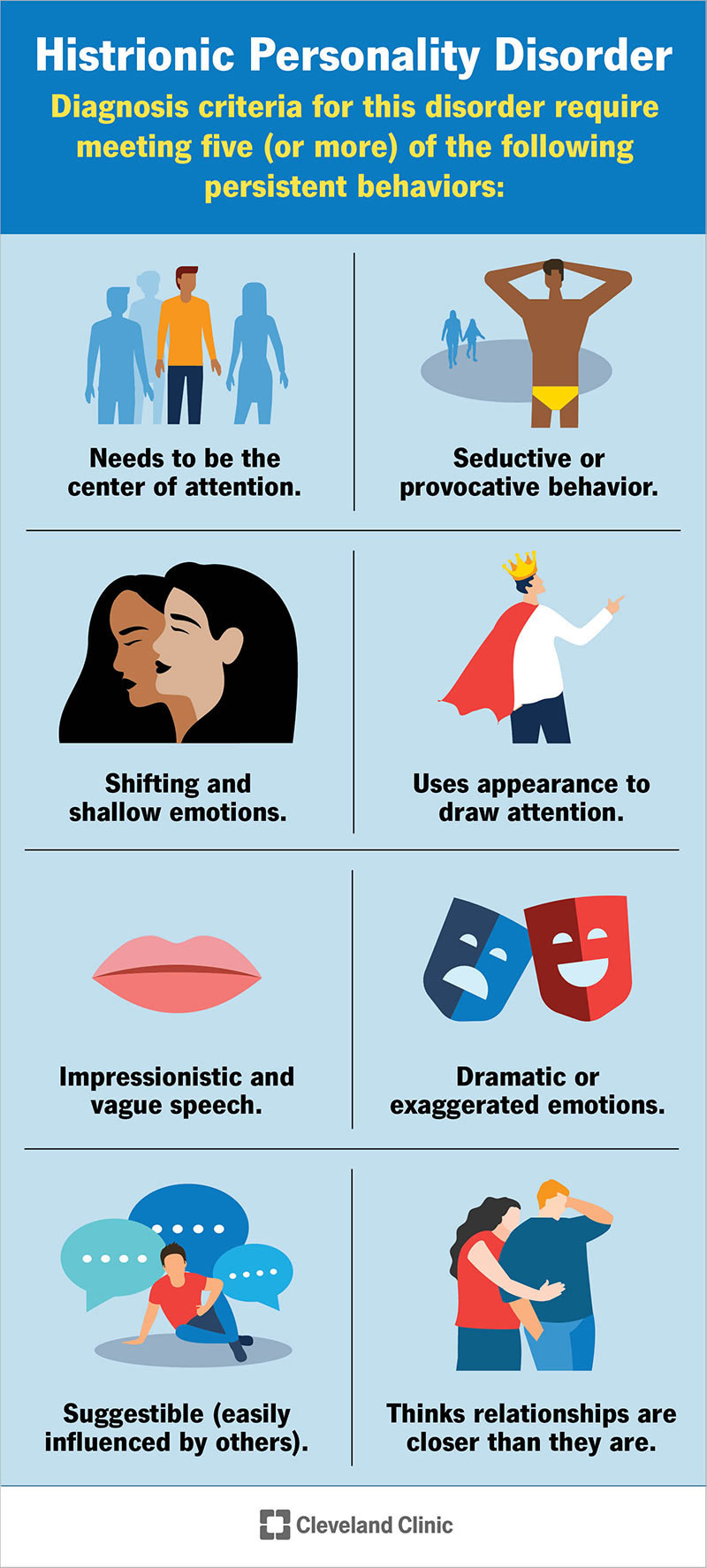Histrionic personality disorder (HPD) is a mental health condition marked by unstable emotions, a distorted self-image and an overwhelming desire to be noticed. People with HPD often behave dramatically or inappropriately to get attention.
Advertisement
Cleveland Clinic is a non-profit academic medical center. Advertising on our site helps support our mission. We do not endorse non-Cleveland Clinic products or services. Policy

Histrionic personality disorder (HPD) is a mental health condition marked by intense, unstable emotions and a distorted self-image. The word “histrionic” means “dramatic or theatrical.”
Advertisement
Cleveland Clinic is a non-profit academic medical center. Advertising on our site helps support our mission. We do not endorse non-Cleveland Clinic products or services. Policy
For people with histrionic personality disorder, their self-esteem depends on the approval of others and doesn’t come from a true feeling of self-worth. They have an overwhelming desire to be noticed and often behave dramatically or inappropriately to get attention.
People with histrionic personality disorder often don’t realize their behavior and way of thinking may be problematic.
Histrionic personality disorder is one of a group of conditions called “Cluster B” personality disorders, which involve dramatic and erratic behavior.
Histrionic personality disorder usually begins in your late teens or early 20s.
Females are more commonly diagnosed with histrionic personality disorder. But researchers think males may be underdiagnosed.
Histrionic personality disorder is relatively rare. Researchers estimate that about 1% of people have the condition.
The main feature of histrionic personality disorder is displaying excessive, superficial emotionality and sexuality to draw attention to themselves.
A person with histrionic personality disorder may:
Advertisement
Personality disorders, including histrionic personality disorder, are among the least understood mental health conditions.
Studies that have been done about histrionic and other personality disorders have identified several factors that may lead to the development of histrionic or other personality disorders:
Personality continues to evolve throughout child and adolescent development. Because of this, healthcare providers don’t typically diagnose someone with histrionic personality disorder until after the age of 18.
Personality disorders, including histrionic personality disorder, can be difficult to diagnose since most people with a personality disorder don’t think there’s a problem with their behavior or way of thinking.
When they do seek help, it’s often due to conditions such as anxiety or depression due to the problems created by their personality disorder, such as divorce or lost relationships, and not the disorder itself.
When a mental health professional, such as a psychologist or psychiatrist, suspects someone might have histrionic personality disorder, they often ask broad, general questions that won’t create a defensive response or hostile environment. They ask questions that will shed light on:
Because a person suspected of having histrionic personality disorder may lack awareness of their behaviors, mental health professionals might ask to collect information from the person’s family and friends.
Mental health providers base a diagnosis of histrionic personality disorder on the criteria for the condition in the American Psychiatric Association’s Diagnostic and Statistical Manual of Mental Disorders.
Advertisement
Diagnosis criteria for histrionic personality disorder require meeting five (or more) of the following persistent behaviors:
In most cases, people with histrionic personality disorder (HPD) don’t believe their behaviors are problematic. They also tend to exaggerate their feelings and dislike routine, which makes following a treatment plan difficult. However, they might seek help if depression — possibly associated with a loss or a failed relationship — or another problem caused by their thinking and behavior causes them distress.
Psychotherapy (talk therapy) is generally the treatment of choice for histrionic or other personality disorders. The goal of treatment is to help the person uncover the motivations and fears associated with their thoughts and behavior and to help the person learn to relate to others more positively.
Types of psychotherapy that may benefit people with histrionic personality disorder include:
Advertisement
Advertisement
While there’s currently no medication that can treat personality disorders, there is medication for depression and anxiety, which people with histrionic personality disorder may also have. Treating these conditions can make it easier to treat histrionic personality disorder.
People with histrionic personality disorder (HPD) are at a higher risk of developing depression and substance use disorders, such as cannabis use disorder and alcohol use disorder.
People with HPD are also more likely to have:
Extreme attention-seeking behavior in people with HPD may involve frequent suicidal threats and gestures.
While there’s no cure for histrionic personality disorder (HPD), many people who have the condition often have productive lives. People with HPD who participate in talk therapy tend to have better outcomes as they gain insight into their condition and function better socially.
However, people with severe histrionic personality disorder may experience frequent problems at work and in social and/or romantic relationships.
While histrionic personality disorder generally can’t be prevented, treatment can allow a person who’s prone to this condition to learn more productive ways of dealing with triggering behaviors, thoughts and situations.
It’s important to remember that histrionic personality disorder is a mental health condition. As with all mental health conditions, seeking help as soon as symptoms appear can help decrease the disruptions to your life. Mental health professionals can offer treatment plans that can help you manage your thoughts and behaviors.
The family members of people with histrionic personality disorder often experience stress, depression, grief and isolation. It’s important to take care of your mental health and seek help if you’re experiencing these symptoms.
Your mental well-being is just as important as your physical well-being. Cleveland Clinic’s mental health experts can help you live life to the fullest.

Last reviewed on 04/29/2022.
Learn more about the Health Library and our editorial process.